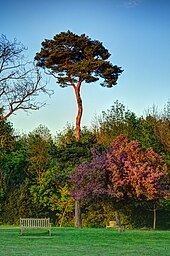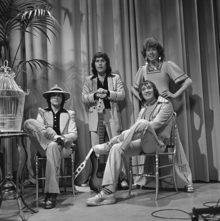Carshalton
Carshalton consists of a number of neighbourhoods. The main focal point, Carshalton Village, is visually scenic and picturesque. At its centre it has two adjoining ponds, which are overlooked by the Grade II listed All Saints Church on the south side and the Victorian Grove Park on the north side. The Grade II listed Honeywood Museum sits on the west side, a few yards from the water. There are a number of other listed buildings, as well as three conservation areas, including one in the village. In addition to Honeywood Museum, there are several other cultural features in Carshalton, including the Charles Cryer Theatre and an art gallery in Oaks Park. It is also home to the Sutton Ecology Centre, and every year an environmental fair is held in Carshalton Park to the south of the village.
Carshalton is part of the Carshalton and Wallington parliamentary constituency formed in 1983. Tom Brake (Liberal Democrat) was its MP from 1997 to 2019, and Elliot Colburn (Conservative) was the MP from 2019 to 2024. As of 2024, Bobby Dean (Liberal Democrat) is the current MP.
The combined population of the five wards comprising Carshalton was 45,525 at the 2001 census. A majority of the population of Carshalton is in the ABC1 social group. In the 2011 Census the wards had been merged into 3 with a total population of 29,917.
History


To the south of the area now known as Carshalton, remains of artefacts dating from the Neolithic to the Iron Age have been found, suggesting that this was an early place of habitation. Prior to the Norman Conquest it is recorded that there were five manors in this location owned by five freemen.
The village lay within the Anglo-Saxon administrative division of Wallington hundred.
Carshalton appears in Domesday Book as Aultone. It was held by Goisfrid (Geoffrey) de Mandeville. Its domesday assets were: 3½ hides; 1 church, 10 ploughs, 1 mill worth £1 15s 0d, 22 acres (89,000 m) of meadow, woodland worth 2 hogs. It rendered £15 10s 0d.
In the Domesday era there was a church and a water mill in Carshalton, which was then still made up of a number of hamlets dotted around the area, as opposed to a single compact village.
In the Middle Ages the land in the village was generally farmed in the form of a number of open fields, divided into strips. The number of strips which each land owner possessed was based roughly on his wealth. There was also an area of open downland in the south of the parish for grazing sheep.
Carshalton was known for its springs; these may have given the place its name Cars – Aul – ton. Aul means well or spring. A ton is a farm which was in some way enclosed. The meaning of the Cars element is uncertain but early spellings (Kersaulton and Cresaulton) may indicate connection with a cross or perhaps cress, watercress having been grown locally.
In his book History of the Worthies of England, the 17th century historian Thomas Fuller refers to Carshalton for its walnuts and trout.
Land was primarily put to arable use and the river Wandle gave rise to manufacturing using water power. A water mill to grind corn was mentioned in the Domesday Book. By the end of the 18th century it was recorded that there were several mills for the production of paper and parchment, leather, snuff, log-wood and seed oil. There were also bleaching grounds for calico.
There were timber-framed houses from the end of the Middle Ages, and brick and wooden weather boarded houses from the 17th, 18th and 19th centuries. By the middle of the 19th century Carshalton's population was 2,411, making it, at the time, the largest village in what was to become the London Borough of Sutton. It had a very varied character with houses for the wealthy at one extreme and tenements in back yards at the other. In 1847 a railway line was laid from Croydon to Epsom through Carshalton, but the first station was built in fields south of Wallington. A station in the village itself was not established until 1868 when the Sutton to Mitcham Line was constructed. The development of Carshalton got into its stride in the early 1890s when the Carshalton Park Estate was sold for housing development.
Carshalton is mentioned in the following historic Surrey folk-rhyme:

During the Victorian era and into the early 20th century, Carshalton was known for its lavender fields (also see below under "Landmarks"), but the increasing land demand for residential building put an end to commercial growing.
The Commonwealth War Graves Commission lists 78 civilian casualties in Carshalton during World War II.

Carshalton formed part of the Carshalton Urban District from 1894 to 1965; the UDC was based at the Carshalton Council Offices in The Square until the 1920s when it moved to The Grove.
Geography

Central Carshalton, around the ponds and High Street, retains a village character, although the busy A232 runs through the area. There are a number of buildings and open spaces protected by the Carshalton Village Conservation Area. given the status by the London Borough of Sutton. In 1993 its boundary was extended to include parts of Mill Lane and parts of The Square and Talbot Road, containing the All Saints Church Rectory. The Conservation Area contains many of the Listed and Locally Listed Buildings which contribute to the historical significance of the area, and is widely considered to contain some of the finest historical architecture and road layout within the Borough. An example is Stone Court, an early 19th-century building with a gate house, situated on the northern edge of Grove Park. The Sun public house, is a fine example of Victorian decorative brickwork, and makes a positive contribution to the Conservation Area.
The Conservation Area also comprises open parkland of historical importance, including the grounds of Carshalton House Estate (which contains St. Philomena's Catholic School, St Mary's Junior School, St Mary's Infants School and the Water Tower) and The Grove Park (which contains The Grove).

Other conservation areas in Carshalton are the Wrythe Green Conservation Area and the Park Hill Conservation Area.
Sutton is centred 1.2 miles (1.9 km) west of the town centre of Carshalton, its east–west central street can be considered a continuation of Carshalton's own main street, an almost straight A-road route to Orpington via Croydon, beginning in Ewell.
Carshalton-on-the-Hill is the residential area on the high chalk upland ground to the south of Carshalton Park from Boundary Road in the east, Crichton Road/Queen Mary's Avenue/Diamond Jubilee Way in the west and the smallholdings of Little Woodcote to the south. In the heart of Carshalton-on-the-Hill is Stanley Park (which is often used as a term to describe the area).
Carshalton Beeches is the area to the west of Carshalton-on-the-Hill, from Crichton Road/Queen Mary's Avenue/Diamond Jubilee Way in the east, Banstead Road/Banstead Road South in the west and Fairlawn Road to the south. It grew up around the railway station which was named after Beeches Avenue, a street near to its location; which, in turn, is named after the beech trees which line it.
The Wrythe lies between Carshalton village to the south and St Helier to the north-west. Its name is thought to derive from the rye that was once grown in this area, or from the Anglo-Saxon word rithe which means a small stream. During the time of the Roman occupation of the British Isles, a small spring was situated near the green, now adjacent to a BP garage. Roman activity in the area is confirmed by the fact that there was once a Roman Villa built in Beddington, just a couple of miles away, and a number of roads in the vicinity of Roman origin. The spring has since disappeared under ground and the culvert it feeds flows into the Wandle near Hackbridge.
Landmarks


All Saints Church
The Grade II* listed Anglican parish church of All Saints is located at the west end of Carshalton High Street, opposite Carshalton Ponds. A church has stood on this site since at least Norman times and probably much longer. The current church contains 12th century work; the tower is the oldest part of the building and is thought to date back to before the Norman Conquest. The church has been much extended over the centuries: the north side, which most visitors see first, is a Victorian facade constructed mostly of dark flint; but the south side is earlier, and shows signs of the many alterations that have been made. The most significant change to the building was in 1891 when a new nave and north aisle were added. The dramatic west end gallery, which accommodates the large three manual Willis Organ, was designed by the Anglo-catholic architect Ninian Comper.
Just outside the churchyard wall is a spring locally known as "Anne Boleyn's Well". It is popularly said to have received this name because it appeared when Anne Boleyn's horse kicked a stone and a spring of water appeared. But the more likely explanation is that the name is a corruption of "Boulogne". The Counts of Boulogne owned land here in the 12th century and there may have been a chapel dedicated to Our Lady of Boulogne near the well.
Strawberry Lodge
Constructed in 1685, Strawberry Lodge is one of Carshalton's oldest buildings. It was built by Josias Dewye who was described in records at the time as a 'clothworker and citizen of London'. In the late 17th century Josias moved from Chilworth to Carshalton to run a Gunpowder Mill on the River Wandle and decided to make his home nearby at the lodge.
Located on the corner of Strawberry Lane and Mill Lane, Strawberry Lodge is owned by Carshalton Baptist Church. Besides being a place of worship it is also used during the week as a conference and training centre. During the 1990s the site was renovated by the Baptist Church supported by the London Borough of Sutton.
Lavender Fields

There are two historic lavender fields. One, at Oaks Way, Carshalton Beeches is a not-for-profit community project that manages three acres of lavender. The other, a 25-acre commercial site in Croydon Lane called Mayfield, is popular with tourists. It is located just within the Carshalton South and Clockhouse ward within the London Borough of Sutton. This area was once famous as the "Lavender Capital of the World". From the 18th to the early 20th centuries the North Downs of Surrey, with its chalky free-draining soil, ideal for lavender growing, were at the centre of worldwide production of lavender. It was a very prosperous part of the local agriculture. Blue fields could be seen all over Mitcham, Croydon, Wallington, Banstead, Carshalton and Sutton. The scale of the operation can be understood from the fact that the Daily News in 1914 was able to state:
At Carshalton Beeches in every direction the low hill sides of the farm beyond Beeches Halt are swept with the bloomy pastel tint of the lavender flowers.
Carshalton House Water Tower

The Grade II* listed Water Tower (or Bagnio as it was known at the time) was built in the early 18th century, primarily to house a water driven pump supplying water to Carshalton House (now St Philomena's School) and the fountains in its gardens. It was planned as a multi-purpose building, and also contains an orangery, a saloon and a bathroom which retains original Delft tiles. The Water Tower is also surrounded by a garden, which features an 18th-century Hermitage, which was restored in the early 1990s, as well as the rustic-style "Folly Bridge".
Little Holland House
Little Holland House in Carshalton Beeches was the home of the artist and designer Frank Dickinson (1874–1961). Dickinson's Arts and Crafts style interior was influenced by the writings of John Ruskin and William Morris. The house contains many of his art works. Dickinson built his house between 1902 and 1904, and achieved a unique blend of traditional and Art Nouveau, which has featured in several recent TV series on architectural history. Inside the Grade II listed interior are his hand-made furniture, paintings, interior decoration, carvings and metalwork. Dickinson named his house as a homage to George Frederick Watts, the Victorian artist, sculptor and social campaigner, whose ideals he greatly admired.
The House is now open to members of the public on the first Sunday of every month, plus the Sunday and Monday of Bank Holiday weekends, between 11am and 5pm. Admission is free.
The Orangery
The Orangery in The Square was built in the second half of the 18th century in Carshalton Park (the section of which between here and Ruskin Road has since been built over). It is thought to have been built by one George Taylor, who owned plantations in the West Indies. By the late 19th century the Orangery was being used a stable. It is now used as office space, for the Environment Agency. It was renovated in 1987 by film actor Oliver Reed (and his son Mark) at his own expense.
The Oaks bakehouse
The late 19th century bakehouse in Oaks Park is all that remains of "The Oaks" mansion which burned down and was demolished in the 1950s. The original bread oven remains in situ. Blocks of burnt bricks from the ruins of the great house were used by local builders to construct garden walls for houses all along Woodmansterne Road, and may still be seen today.













